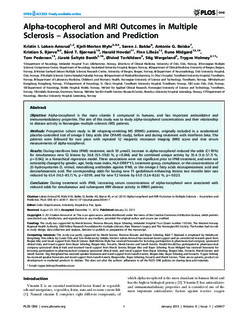| dc.contributor.author | Løken-Amsrud, Kristin Ingeleiv | |
| dc.contributor.author | Myhr, Kjell-Morten | |
| dc.contributor.author | Bakke, Søren Jacob | |
| dc.contributor.author | Beiske, Antonie Giæver | |
| dc.contributor.author | Bjerve, Kristian S | |
| dc.contributor.author | Bjørnarå, Bård T. | |
| dc.contributor.author | Hovdal, Harald Olav | |
| dc.contributor.author | Lilleås, Finn | |
| dc.contributor.author | Midgard, Rune | |
| dc.contributor.author | Pedersen, Tom | |
| dc.contributor.author | Saltyte Benth, Jurate | |
| dc.contributor.author | Torkildsen, Øivind | |
| dc.contributor.author | Wergeland, Stig | |
| dc.contributor.author | Holmøy, Trygve | |
| dc.date.accessioned | 2015-11-20T10:44:23Z | |
| dc.date.accessioned | 2016-05-19T14:34:34Z | |
| dc.date.available | 2015-11-20T10:44:23Z | |
| dc.date.available | 2016-05-19T14:34:34Z | |
| dc.date.issued | 2013 | |
| dc.identifier.citation | PLoS ONE 2013, 8(1) | nb_NO |
| dc.identifier.issn | 1932-6203 | |
| dc.identifier.uri | http://hdl.handle.net/11250/2389842 | |
| dc.description.abstract | Objective: Alpha-tocopherol is the main vitamin E compound in humans, and has important antioxidative and immunomodulatory properties. The aim of this study was to study alpha-tocopherol concentrations and their relationship to disease activity in Norwegian multiple sclerosis (MS) patients.
Methods: Prospective cohort study in 88 relapsing-remitting MS (RRMS) patients, originally included in a randomised placebo-controlled trial of omega-3 fatty acids (the OFAMS study), before and during treatment with interferon beta. The patients were followed for two years with repeated 12 magnetic resonance imaging (MRI) scans and nine serum measurements of alpha-tocopherol.
Results: During interferon beta (IFNB) treatment, each 10 µmol/L increase in alpha-tocopherol reduced the odds (CI 95%) for simultaneous new T2 lesions by 36.8 (0.5–59.8) %, p = 0.048, and for combined unique activity by 35.4 (1.6–57.7) %, p = 0.042, in a hierarchical regression model. These associations were not significant prior to IFNB treatment, and were not noticeably changed by gender, age, body mass index, HLA-DRB1*15, treatment group, compliance, or the concentrations of 25-hydroxyvitamin D, retinol, neutralising antibodies against IFNB, or the omega-3 fatty acids eicosapentaenoic acid and docosahexaenoic acid. The corresponding odds for having new T1 gadolinium enhancing lesions two months later was reduced by 65.4 (16.5–85.7) %, p = 0.019, and for new T2 lesions by 61.0 (12.4–82.6) %, p = 0.023.
Conclusion: During treatment with IFNB, increasing serum concentrations of alpha-tocopherol were associated with reduced odds for simultaneous and subsequent MRI disease activity in RRMS patients. | nb_NO |
| dc.language.iso | eng | nb_NO |
| dc.publisher | Public Library of Science | nb_NO |
| dc.rights | Navngivelse 3.0 Norge | * |
| dc.rights.uri | http://creativecommons.org/licenses/by/3.0/no/ | * |
| dc.title | Alpha-tocopherol and MRI outcomes in multiple sclerosis - association and prediction | nb_NO |
| dc.type | Journal article | nb_NO |
| dc.type | Peer reviewed | nb_NO |
| dc.date.updated | 2015-11-20T10:44:23Z | |
| dc.subject.nsi | VDP::Medisinske fag: 700::Klinisk medisinske fag: 750::Nevrologi: 752 | nb_NO |
| dc.subject.nsi | VDP::Midical sciences: 700::Clinical medical sciences: 750::Neurology: 752 | nb_NO |
| dc.source.volume | 8 | nb_NO |
| dc.source.journal | PLoS ONE | nb_NO |
| dc.source.issue | 1 | nb_NO |
| dc.identifier.doi | 10.1371/journal.pone.0054417 | |
| dc.identifier.cristin | 1024383 | |
| dc.description.localcode | © 2013 Løken-Amsrud et al. This is an open-access article distributed under the terms of the Creative Commons Attribution License, which permits unrestricted use, distribution, and reproduction in any medium, provided the original author and source are credited. | nb_NO |

